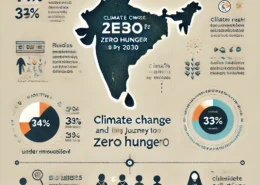Outlining the reasons behind forest fires and the steps India can take to stop them from happening. (Answer in 200 words)
Model Answer Introduction Global warming is a critical environmental challenge characterized by the long-term rise in average temperatures due to the accumulation of greenhouse gases (GHGs) in the atmosphere. This increase in temperature has profound effects on global climate patterns, leading to moRead more
Model Answer
Introduction
Global warming is a critical environmental challenge characterized by the long-term rise in average temperatures due to the accumulation of greenhouse gases (GHGs) in the atmosphere. This increase in temperature has profound effects on global climate patterns, leading to more frequent and intense extreme weather events, melting glaciers and polar ice caps, rising sea levels, and disruptions to ecosystems.
Effects of Global Warming
- Extreme Weather Events: The frequency and intensity of hurricanes, droughts, and heavy rainfall are increasing, causing significant damage to infrastructure and ecosystems.
- Melting Ice Caps: Glaciers and polar ice caps are melting at an alarming rate, contributing to rising sea levels and threatening coastal communities.
- Rising Sea Levels: Higher sea levels lead to increased flooding in coastal areas, displacing populations and affecting freshwater supplies.
- Ecosystem Disruption: Changes in temperature and precipitation patterns disrupt habitats, leading to species loss and altered biodiversity.
Control Measures: The Kyoto Protocol
To address the rising levels of GHGs and combat global warming, the Kyoto Protocol was adopted in 1997. This international treaty aimed to reduce emissions of six primary GHGs: carbon dioxide (CO2), methane (CH4), nitrous oxide (N2O), hydrofluorocarbons (HFCs), perfluorocarbons (PFCs), and sulfur hexafluoride (SF6).
Key Features of the Kyoto Protocol
- Emission Reduction Targets: Binding targets were established for developed countries (Annex I countries) to reduce their GHG emissions to specified levels below their 1990 baseline.
- Clean Development Mechanism (CDM): This mechanism allowed Annex I countries to invest in emission reduction projects in developing countries, earning carbon credits while promoting sustainable development.
- Joint Implementation (JI): JI enabled Annex I countries to collaborate on emission reduction projects and earn emission reduction units (ERUs) as credits.
- Emissions Trading: The protocol introduced a market-based approach, allowing countries to buy and sell emission allowances, providing flexibility in meeting targets.
- Technology Transfer and Financial Assistance: Emphasis was placed on transferring technology and providing financial support from developed to developing countries to aid in reducing GHG emissions.
While the Kyoto Protocol raised global awareness about climate change and established a framework for international cooperation, it faced challenges due to limited participation and lack of binding commitments from major emitters like the United States and China. Nonetheless, it laid the groundwork for subsequent agreements, such as the Paris Agreement in 2015.
Conclusion
The Kyoto Protocol was instrumental in addressing global warming by setting emission reduction targets for participating countries. Effective control measures to curb GHG emissions include adopting renewable energy sources, improving energy efficiency, implementing carbon pricing mechanisms, and promoting sustainable practices. Continued international cooperation and adherence to such protocols are essential for mitigating the detrimental effects of global warming and achieving a sustainable future.
See less

Causes of Forest Fires in India: Human Activities: Slash-and-burn agriculture, land clearing, poaching, discarded cigarettes, campfires, fireworks, and intentional fires for new grass growth often lead to uncontrolled fires. Natural Causes: Lightning ignites dry vegetation, and prolonged dry spellsRead more
Causes of Forest Fires in India:
Measures to Prevent Forest Fires in India:
Implementing these measures can significantly reduce the incidence and impact of forest fires in India, preserving biodiversity and protecting local communities.
See less